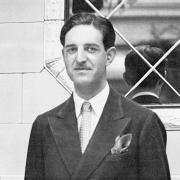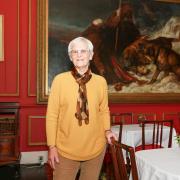A tower on the Lancashire coast provided the inspiration for one of our greatest novelists. Susan Riley reports Photography by Darren Andrews
Lancashire is dotted with extravagant Victorian follies. Many are in public places but one, Lindeth Tower, is tucked away in the middle of a beautiful garden in the north Lancashire coastal village of Silverdale.
What makes it so special is its association with the great Victorian author Elizabeth Gaskell. She used the four-storey tower in the 1840s and 50s when she escaped the Manchester smog to holiday by the coast. She wrote her novel, Ruth, in the tower shortly after it was built, no doubt inspired by the stunning views across Morecambe Bay and to the Howgills.
Every two years the owner Joy Sharp opens the tower and gardens to the Gaskell Society which members include on their pilgrimage to the north west. Silverdale also named its village hall after the famous author whose novels include North and South, Wives and Daughters and Cranford which was successfully serialised by the BBC a couple of years ago.
Mrs Gaskell first holidayed in Silverdale in 1843 when she and her family stayed for a month. In following years she often used to visit, sometimes staying at nearby Gibraltar Farm and Lindeth Lodge, now known as the Wolf House Gallery. Letters published during her holidays in the village reveal that the famous writer was less than enamoured with the tower.
‘Lindeth Tower sounds very grand but it is a queer ugly square tower in our garden - the latter is full of weeds,’ she wrote June 1858. But it seems the entire family was charmed by the north Lancashire village and Mrs Gaskell’s daughters, Meta and Julia, had a holiday home called The Sheilings built in woodland in nearby Hollins Lane.
Joy, who bought Tower House 20 years ago, muses that there is no mention of the Preston banker Hesketh Fleetwood in the village. He built the tower in 1842 and also owned a lot of land in the village.
Joy had always been told that the town of Fleetwood was named after him but it is more likely that it was Henry Paul Fleetwood who built the tower, a relation of Sir Peter Hesketh Fleetwood.
‘It was an old cottage and he came and added a wing and the tower and the walls all around,’ said Joy. The tower is now listed and the 12ft stone walls which border the garden are currently being looked at by English Heritage to see if steps which lead to the top of them should have a separate listing.
‘My theory is that Fleetwood chose this spot because as a shipper and a banker he could see his ships going across the mouth of the bay over to Barrow,’ added Joy. ‘ There was a very busy trade with Milnthorpe beforethe railway.
‘He could sit up in the tower, I think he was up there counting his shekels! It’s amazing there’s nothing here named after Fleetwood.’
When Joy, a history graduate, bought the house with her family she knew it was the perfect place for them and soon set about changing the tower’s 1960s d�cor. ‘The windows had bark pelmets and net curtains. I thought why do you buy a tower and put in lace curtains?’ she said.
It now has a small kitchen and bathroom on the ground floor, bedroom on the first floor with a living area above and access to the roof which has marvellous views over the sands and nearby countryside. It has storage heaters and also an open fire so it is habitable most of the year - a fact Joy and her family take advantage of.
Joy also set about redesigning the garden, removing conifers and opening up the land which is just under an acre. The high walls which surround the garden create a microclimate where Joy successfully grows cherries and figs.
The house and tower had previously been owned by Margaret Horsley who bought it in the 1960s from a local recluse who had let the tower fall into disrepair. Mrs Horsley completely restored the tower and Joy said both she and her predecessor had a deep love for the place.
Two of Joy’s daughters had their wedding celebrations in the gardens and both lived in the tower as adults. Joy also lived in it for four months while she did up the main house and she still enjoys using it.
One of her favourite memories is of being at the top of the tower at the millennium, drinking champagne and watching all the fireworks going off. ‘I hope when I go someone will come in and love it, too’ she said. Although she has no plans to move. ‘It’s a property which gets underneath the skin, it’s so perfect.’
The tower not only inspired Mrs Gaskell. Latterly other writers have stayed there and it has also prompted a CD by Lancashire singer-sonwriter by Ian Bailey. It was called Tower Sings.
However, it is the Mrs Gaskell connection which has an enduring fascination. Joy often finds groups of Japanese visitors standing outside her garden gate. ‘If I am not too busy I will show them round,’ she said.Her nine grandchildren also love to visit. ‘They call it granny’s chimney,’ said Joy. "It’s absolute magic.’ Every spring it gets a thorough clean but she says apart from that the upkeep is fairly minimal. ‘I have a son-in-law who abseils down and cleans the windows for me.’
Stay at the tower
Joy lets the tower on an informal basis for short breaks in the summer and early autumn. Lancashire Life readers can get more information by contacting her on 01524 701457.
Meanwhile, the Manchester home Elizabeth Gaskell shared with her clergyman husband has undergone the first phase of long overdue restoration. Authentic lime plaster has replaced the 1960s cement render and windows and shutters, most of which have survived since 1838, have been repaired by skilled joiners.
The restorers discovered dry rot in the roof and in the cellar. This has been treated and the huge stone pediment at the top of the building was teetering on a single row of bricks and some timbers, but is now secure. The house, at 84, Plymouth Grove, is now open on the first Sunday of the month from 12-4pm.
Silverdale 200 celebration
This is a significant year in the history of Silverdale and it is being marked with a weekend of events on July 16 and 17. Several interesting houses are opening to the public as part of the village’s history trail.
Lindeth Tower and gardens will be open from 9.30am on both days and there will be readings in the garden by the Gaskell Society. There will also be guided history trails in the village.In 1811 Parliament passed an ‘Act for Inclosing & Embanking Lands within the townships of Warton with Lindeth, and Silverdale, in the parish of Warton in the county palatine of Lancaster.’ This is the start of the village as we know it today.


























